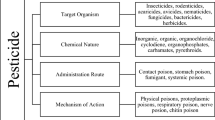Abstract
The benzoxazolinone BOA and the degradation products APO, AAPO and HPAA, as well as four structure related compounds to BOA, were tested for their lethal and sublethal effects on the collembola Folsomia candida and on the carabid beetle Poecilus cupreus applying validated standard laboratory methods. According to the results of the recommended risk assessment for plant protection products (EPPO, 2003), BOA and its structure related compounds carbendazim, benoxacor and benazolin (and additionally the formulated product Cresopur®) were classified as low risk compounds for both test organisms. Phosalone was of high risk for F. candida. APO, AAPO and HPAA were of medium risk for F. candida, but were rated as low risk compounds for P. cupreus at the tested rates of about 2 mg/kg substrate. However, as the BOA degradation products have been found to occur at field rates below 0.2 mg/kg substrate or are often even not detectable, it is assumed that their potential risk for both non-target soil organisms in the field will be acceptable.
Similar content being viewed by others
References
Abbott W.S., (1925). A method of computing the effectiveness of an insecticideJ. Econ. Entomol. 18: 265–7
Achazi, R.K., Römbke, J. and Riepert, F. (2000). Collembolen als Testorganismen. In S. Heiden, R. Erb, W. Dott, and A. Eisenträger (eds.), Toxikologische Beurteilung von Böden: Leistungsfähigkeit biologischer Testverfahren. Spektrum Akademischer Verlag, pp. 83–103
Anonymus (1967). EU-Council Directive 67/548/EEC of 27 June 1967 on the approximation of the laws, regulations and administrative provisions relating to classification, packaging and labelling of dangerous substances. Official J. No. 196, 16/08/1967, pp. 0001–5
Anonymus (1991). EU Council Directive 91/414/EEC of 15th July 1991 concerning the placing of plant protection products on the market Official J. Eur. Comm. L230: 1–32
Anonymus (2003). Environmental risk assessment scheme for plant protection products. Chapter 8: Soil organisms and functions. EPPO Bull. 33(2): 195–209
Eljarrat E., Barcelo D., (2001). Sample handling and analysis of allelochemical compounds in plantsTrends Anal. Chem. 20(10): 584–90
Eijsackers H. (1978). Side effects of the herbicide 2,4,5-T affecting mobility and mortality of the springtail Onychiurus quadriocellatus Gisin (Collembola). J. Appl. Entomol. 86: 349–72
Fomsgaard I.S., Mortensen A.G., Carlsen S.C.K., (2004a). Microbial transformation products of benzoxazinone and benzoxazinone allelochemicals – a reviewChemosphere 54: 1025–38
Fomsgaard, I.S., Mortensen, A.G., Gents, M.B. and Understrup, A.G. (2004b). Time-dependent transformation of varying concentration of the hydroxamic acid metabolites MBOA and BOA in soil. Proceedings Second European Allelopathy Symposium, Pulawy, 03.-05.06.2004, Poland, pp. 61–3
Fomsgaard, I.S., Mortensen, A.G., Idinger, J., Coja, T. and Bluemel, S. (2005a). Chemical analysis of soil after ecotoxicological testing of benzoxazinoids and metabolites on Poecilus cupreus and Folsomia candida. J. Agric. Food Chem., submitted
Fomsgaard, I.S., Mortensen, A.G., Nielsen, S.T. and Christoffersen, C. (2005b). Time dependent transformation in soil of low concentrations of 3-methoxy-2-benzoxazoline (MBOA) – an allelochemical from wheat. J. Agric. Food Chem., submitted
Gents, M.B., Nielsen, S.T., Mortensen, A.G., Christoffersen, C. and Fomsgaard, I.S. (2004). Transformation products of 2-benzoxazolinone (BOA) in soil. Chemosphere, 61(1): 74–84
Heimbach U., Baier B., Barth M., Blümel S., Geuijen I., Jäckel B., Maus C., Nienstedt K.M., Schmitzer S., Stäbler P., Ufer A., Winkelmann G., (2002). First ring test results of a laboratory method to evaluate effects of plant protection products on larvae of Poecilus cupreus (Coleoptera: Carabidae)IOBC/WPRS Bull. 25(11): 19–26
Idinger J., (2002). Laboratory studies to detect effects of selected plant protection products on Folsomia candida (Collembola: Isotomidae)J. Plant Dis. Protect. 109(5): 512–29
Idinger, J., Coja, T. and Blümel, S. (2005). Effects of the benzoxazoid DIMBOA, selected degradation products and structure related pesticides on soil organisms. Ecotoxicol. Environ. Safety, accepted
ISO (1999). International Standard 11267: Soil quality – Inhibition of reproduction of Collembola (Folsomia candida) by soil pollutants. International Organization for Standardization, Geneva, 16 p
Krogh, P.H. and Peterson, B. (1995). Laboratory toxicity testing with Collembola. In H. Løkke (ed.), Effects of Pesticides on Meso- and Micro-Fauna in Soil. Danish Environmental Protection Agency, pp. 39–58
Macias, F.A., Oliveros Bastidas, A., Marin, D., Castellano, D., Simonet, A.M. and Molinillo, J.M.G. (2004). Degradation studies on benzoxazinoids: Part 1. Evaluation of DIBOA transformations in soil. J. Agric. Food Chem. 52(21): 6402–13
Mead-Briggs M., 1998. The value of large-scale field trials for determining the effects of pesticides on the non-target arthropod fauna of cereal crops. In: Haskell P.T., McEwen P.T., (Ed.), Ecotoxicology: Pesticides and Beneficial Organisms. Kluwer Academic Publishers, Dordrecht, pp. 182–90
Sabatini M.A., Ribecchi L., Cappi C., Guidi A., Dinelli G., Vicari A., Bertolani R., (1998). Side effects of the herbicide triasulfuron on collembolan under laboratory conditionsChemosphere 37(14–15): 2963–73
Understrup, A.G., Ravnskov, S., Hansen, H.C.B. and Fomsgaard, I.S. (2004). Biotransformation of 2-benzoxazolinine to 2-amino-3H-phenoxazin-3-one and 2-acetylamino-3h-phenoxazin-3-one in soil. J. Agric. Food Chem., 33(2): 195–209
Wilkes M.A., Marshall D.R., Copeland L., (1999). Hydroxamic acids in cereal roots inhibit the growth of take-allSoil Biol. Biochem. 31: 1831–6
Yenish J.P., Worsham A.D., Chilton W.S., (1995). Disappearance of DIBOA-glucoside, DIBOA and BOA from rye (Secale cereale L.) cover crop residueWeed Sci. 43: 18–20
Acknowledgments
The research described in this abstract was performed as part of the project “FATEALLCHEM – Fate and Toxicity of Allelochemicals (natural plant toxins) in Relation to Environment and Consumer”. The project was carried out with financial support from the Commission of the European Communities under the Work Programme Quality of Life, Contract No. QLK5-CT-2001-01967, and from the Agency for Health and Food Safety, Institute for Plant Health, Vienna, Austria. We gratefully acknowledge the technical assistance of H. Hausdorf.
Author information
Authors and Affiliations
Corresponding author
Rights and permissions
About this article
Cite this article
Coja, T., Idinger, J. & Blümel, S. Effects of the Benzoxazolinone BOA, Selected Degradation Products and Structure Related Pesticides on Soil Organisms. Ecotoxicology 15, 61–72 (2006). https://doi.org/10.1007/s10646-005-0042-4
Published:
Issue Date:
DOI: https://doi.org/10.1007/s10646-005-0042-4




